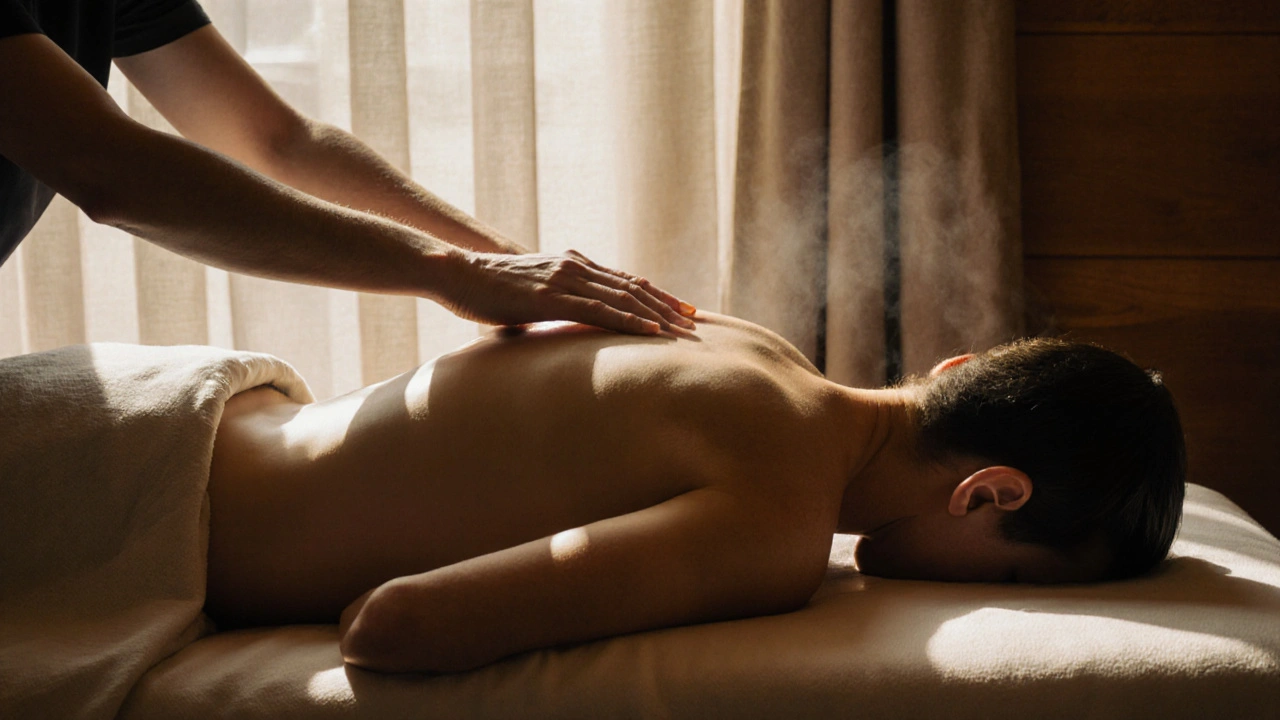The Top 5 Reasons to Try Swedish Massage Today

You’ve probably heard of Swedish massage-but maybe you’ve never tried it. Maybe you think it’s just a fancy name for a regular rubdown. Let me tell you something: Swedish massage isn’t just another option on the spa menu. It’s the foundation of modern massage therapy, and if you’re carrying around stress, tight shoulders, or that low-grade fatigue that never quite goes away, it might be exactly what your body’s been asking for.
Why Swedish Massage Is Different
Swedish massage isn’t about digging into knots with brute force. It’s not deep tissue. It’s not hot stone. It’s not even Thai massage with its stretches and pressure points. Swedish massage is smooth, rhythmic, and intentional. It uses five core techniques: effleurage (long gliding strokes), petrissage (kneading), friction (deep circular movements), tapotement (light tapping), and vibration. Together, they create a wave of relaxation that moves through your muscles like tide rolling in.
Think of it like this: your muscles are like tangled headphones in your pocket. Deep tissue pulls at the knots. Swedish massage gently untangles them-without the yanking.
Reason #1: It Lowers Stress Hormones Fast
Stress isn’t just in your head. It lives in your shoulders, your jaw, your lower back. When you’re overwhelmed, your body pumps out cortisol-the stress hormone. High cortisol levels? That means poor sleep, brain fog, and even weight gain around your midsection.
A 2023 study from the University of Amsterdam found that after just one 60-minute Swedish massage, participants had an average 31% drop in cortisol levels. That’s not a guess. That’s measurable. And the effects? They linger. People reported feeling calmer for up to 72 hours after their session.
Imagine walking out of a massage with your shoulders down, your breathing slower, and that constant mental buzz turned off. That’s Swedish massage.
Reason #2: It Eases Chronic Muscle Tension Without Pain
Do you sit at a desk all day? Do you carry your kids, your groceries, or your laptop like a second skin? Over time, your muscles get stuck in a state of semi-tension. They don’t fully relax-even when you’re sleeping.
Swedish massage doesn’t force them open. It invites them to. The long, flowing strokes increase blood flow to tight areas. That means more oxygen, more nutrients, and faster removal of lactic acid and other metabolic waste. No screaming pain. No bruising. Just a slow, deep release.
One client here in Amsterdam, a teacher who’d been dealing with upper back pain for five years, told me after her third session: "I didn’t realize how much I was holding my breath until I could breathe fully again."
Reason #3: It Improves Sleep Quality
If you’re tossing and turning, counting sheep, or waking up at 3 a.m. with your mind racing-Swedish massage might be the missing piece.
Why? Because it boosts serotonin, the precursor to melatonin. Melatonin is your body’s natural sleep hormone. A 2024 review in the Journal of Clinical Sleep Medicine showed that people who received weekly Swedish massages fell asleep 27% faster and reported deeper sleep cycles compared to those who didn’t.
And here’s the kicker: you don’t need to do this for months. Many people notice better sleep after just one session. No pills. No gadgets. Just hands, oil, and quiet.
Reason #4: It’s Gentle Enough for Everyone
Not everyone can handle deep tissue. Maybe you’re older. Maybe you’re recovering from an injury. Maybe you just don’t like pain. That’s okay. Swedish massage is the most accessible form of professional massage out there.
It’s safe for pregnant women (when done by a trained therapist), people with arthritis, those with high blood pressure, and even people recovering from surgery. The pressure is adjustable-you tell the therapist what feels right. No judgment. No pressure (pun intended).
I’ve seen 78-year-olds come in for their weekly Swedish massage because it’s the only thing that lets them move without stiffness. I’ve seen new moms get relief from the strain of breastfeeding and carrying babies. It’s not a luxury. It’s a tool for everyday life.

Reason #5: It Gives You Mental Clarity
Here’s something most people don’t expect: after a Swedish massage, your brain feels lighter.
Why? Because when your body relaxes, your nervous system switches from "fight or flight" (sympathetic) to "rest and digest" (parasympathetic). That’s when your brain stops running 17 tabs at once. That’s when ideas come clearer. That’s when you stop ruminating on that email you sent three days ago.
One software developer I know started coming every two weeks after burnout. He said: "I used to stare at my screen for hours, not getting anything done. After a massage, I’d come back and solve a problem I’d been stuck on for days. It’s like my brain finally got a reboot."
What to Expect During Your First Session
You’ll lie on a warm table, covered with a sheet. Only the part being worked on is uncovered. The room will be quiet, maybe with soft music or the sound of rain. The therapist will use oil or lotion-usually unscented unless you ask for lavender or eucalyptus.
The session starts with long strokes along your back, legs, and arms. It’s slow. Purposeful. You’ll feel warmth spreading. Then, gentle kneading on your shoulders. Maybe some circular pressure on your hips. You might feel a little ticklish at first. That’s normal. The therapist will check in: "Is this pressure okay?" You say yes or no. That’s it.
Most sessions last 60 or 90 minutes. You’ll leave feeling like you’ve been wrapped in a warm blanket and gently rocked to sleep.
Where to Find Quality Swedish Massage in Amsterdam
Amsterdam has dozens of places offering Swedish massage. But not all are created equal. Look for therapists who are certified by the Dutch Association of Massage Therapists (NVMT). Ask if they specialize in Swedish techniques-not just "relaxation massage," which can mean anything.
Some trusted spots in the city:
- De Stilte (Amsterdam Zuid): Quiet, minimalist space. Therapists trained in medical massage principles.
- Amsterdam Wellness Center (Oud-West): Offers add-ons like warm stones or aromatherapy.
- De Oude Kerk Spa (Centrum): Historic building, peaceful courtyard. Great for tourists.
Don’t be afraid to book a 30-minute intro session. Some places let you try a shorter version before committing to an hour.
How Much Does It Cost?
In Amsterdam, a 60-minute Swedish massage typically runs between €65 and €95. A 90-minute session is usually €100-€130. Prices vary based on location, therapist experience, and whether you’re adding extras like oils or heat.
Some places offer packages: 5 sessions for €300. That’s under €60 per session. If you’re serious about reducing stress or managing pain, it’s worth it. Think of it like a gym membership-but for your nervous system.

What to Avoid
Don’t go in with expectations of deep pain. If a therapist says, "It has to hurt to work," walk out. Swedish massage doesn’t need to hurt to be effective.
Don’t eat a heavy meal right before. A light snack an hour before is fine. Hydrate well after-you’ll flush out toxins more easily.
And don’t skip the post-massage stillness. Give yourself 10 minutes to sit quietly. Drink water. Let your body settle. You’ll get more out of it.
Swedish Massage vs. Deep Tissue Massage
| Feature | Swedish Massage | Deep Tissue Massage |
|---|---|---|
| Primary Goal | Relaxation, circulation, stress relief | Break down chronic muscle tension |
| Pressure | Light to medium | Heavy, focused |
| Techniques | Gliding, kneading, tapping | Slow, deep strokes, friction |
| Pain Level | Minimal to none | Moderate to high |
| Best For | Stress, sleep, general tension | Chronic pain, athletes, injury recovery |
| After Effects | Feeling refreshed, calm | May feel sore for 1-2 days |
Frequently Asked Questions
Is Swedish massage good for anxiety?
Yes. Swedish massage activates the parasympathetic nervous system, which calms your mind and reduces the physical symptoms of anxiety-like rapid heartbeat and shallow breathing. Many therapists in Amsterdam work with clients who have generalized anxiety disorder, using Swedish massage as part of a holistic care plan.
How often should I get a Swedish massage?
For stress relief or general wellness, once every 2-4 weeks works well. If you’re dealing with chronic tension or pain, weekly sessions for 4-6 weeks can create lasting change. After that, you can drop to maintenance mode-every 3-6 weeks. Think of it like brushing your teeth: regular care prevents bigger problems.
Can I get a Swedish massage if I’m pregnant?
Absolutely-when done by a therapist trained in prenatal massage. Special positioning (side-lying or with cushions) keeps you and your baby safe. Many pregnant clients say it’s the only thing that helps with lower back pain and swollen feet. Just avoid it in the first trimester unless your doctor approves.
Do I need to be naked?
No. You’ll be covered with a sheet the whole time. Only the area being worked on is exposed, and you’re always in control. Most people keep their underwear on. The therapist will leave the room while you get positioned. Privacy and comfort come first.
What if I don’t like the pressure?
Speak up. Right away. A good therapist will adjust on the spot. Swedish massage is about your comfort, not their technique. If you’re tense because you’re worried about saying something, you’re not relaxing-and that defeats the whole point. Your voice matters here.
Ready to Feel Lighter?
You don’t need a reason to treat yourself. But if you need one: your body is working hard every day. It deserves to be held gently. Swedish massage isn’t a luxury. It’s a reset button. And today? Today is the perfect day to press it.


